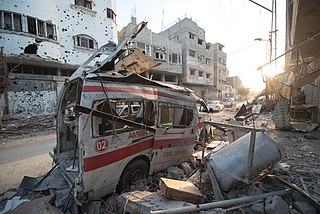
Gaza, also called Gaza City, is a Palestinian city in the Gaza Strip. Prior to the 2023 Israel–Hamas war, it was the most populous city in the State of Palestine, with 590,481 inhabitants in 2017.

Jabalia, also spelled Jabalya, is a city in Palestine located 4 kilometers (2.5 mi) north of Gaza City, in the North Gaza Governorate of the Gaza Strip. According to the Palestinian Central Bureau of Statistics, Jabalia had a population of 172,704 in 2017. The Jabalia refugee camp is adjacent to the city to the north. The nearby town of Nazla is a part of the Jabalia municipality. The city is currently under the operational control of IDF's 162nd Division.
Beit Hanoun or Beit Hanun is a Palestinian city on the northeast edge of the Gaza Strip. According to the Palestinian Central Bureau of Statistics, the town had a population of 52,237 in 2017. As a result of the ongoing Israel-Hamas war, Beit Hanoun has been militarily contested between the Hamas administration and Israel. Furthermore, the town has been entirely depopulated, and virtually all its structures have either been destroyed or rendered unusable due to extreme damage. The remains of Beit Hanoun are located by the Nahal-Hanun stream, 6 kilometers (3.7 mi) away from the Israeli town of Sderot.

The Sayed al-Hashim Mosque is one of the largest and oldest mosques in Gaza, located in the ad-Darrāj Quarter of the Old City, off of al-Wehda Street. The tomb of Hashim ibn Abd al-Manaf, Muhammad's great grandfather who died in Gaza during a trading voyage, is located under the dome of the mosque according to Muslim tradition.

Al-Aqsa University is a public university with campuses in Gaza City and Khan Younis, Palestine. Established in 1955 as a teachers' institute before later expanding its curriculum, it is the first and oldest public higher education institution in the Gaza Strip. It caters for some 26,000 students and has some 1400 employees, 300 of whom are lecturers and professors.

Nuseirat is a Palestinian refugee camp located in the middle of the Gaza Strip, five kilometers north-east of Deir al-Balah. The refugee camp is in the Deir al-Balah Governorate, Gaza Strip. According to the Palestinian Central Bureau of Statistics, the refugee camp had a population of 31,747 and the surrounding Nuseirat municipality had a population of 54,851 in 2017. The camp was established after the 1948 Palestinian expulsion during the 1948 Palestine war.
Al Mat'haf is a small, private museum in Gaza City, Palestine, focused on archaeology of the Gaza Strip. The museum is part of a privately owned hotel, also named Al Mat'haf, that includes a restaurant and conference center; both the hotel and its small museum opened to the public in the fall of 2008. The privately owned museum houses antiquities discovered in the Gaza Strip from various historical periods. The museum is owned by the businessman Jawdat N. Khoudary, who owns a series of construction companies in Gaza.

The Great Mosque of Gaza, also known as the Great Omari Mosque, was the largest and oldest mosque in all of Gaza, Palestine, located in Gaza City.
Umm al-Nasr Mosque or Beit Hanoun Mosque is the oldest mosque in the Palestinian city of Beit Hanoun in the Gaza Strip, located in the center of the city.
Katib al-Wilaya Mosque or Welayat Mosque was a small historic mosque located along Omar Mukhtar Street in Gaza City in the Zaytun Quarter of the Old City. The mosque was built by the Burji Mamluks in 1432, however, the structure could date further back to 1344. Additions to the western part of the mosque were commissioned in 1584 by Ahmed Bey, the Ottoman clerk of the Damascus Vilayet. Damascus Vilayet's Arabic transliteration was Wilayat Dimashq, hence the name of the mosque Katib al-Wilaya.

Tell es-Sakan, lit. "Hill of Ash", is a tell about 5 km south of Gaza City in what is today the Gaza Strip, on the northern bank of Wadi Ghazzeh. It was the site of two separate Early Bronze Age urban settlements: an earlier one representing the fortified administrative center of the Egyptian colonies in southwestern Palestine from the end of the 4th millennium, and a later, local Canaanite fortified city of the third millennium. The location at the mouth of what was probably a palaeochannel of the river, allowed it to develop as an important maritime settlement with a natural harbour. Its geographical location endowed it with a position of importance at the crossroads of land-based trade routes between the Canaan region, the Old Kingdom of Egypt, and Arabia. As of 2000, the early Egyptian settlement was the oldest fortified site known to researchers in both Egypt and Palestine.

Deliberate destruction and theft of cultural heritage have been conducted by the Islamic State (IS) since 2014 in Iraq, Syria, and to a lesser extent in Libya. The destruction targets various places of worship under IS control and ancient historical artifacts. In Iraq, between the fall of Mosul in June 2014 and February 2015, IS plundered and destroyed at least 28 historical religious buildings. Valuable items from some buildings were looted in order to smuggle and sell them to foreigners to finance the running of the Islamic State.

Bilateral relations between Bangladesh and Palestine are close and cordial. Bangladesh has been a consistent supporter of the Palestinians right to an independent state, and has no diplomatic relations with Israel. Furthermore, Bangladesh offers scholarships to young Palestinians, and the two countries co-operate on military affairs.

Israeli war crimes are the violations of international criminal law, including war crimes, crimes against humanity and the crime of genocide, which the Israel Defense Forces, the military branch of the state of Israel, has been accused of committing since the founding of Israel in 1948. These have included murder, intentional targeting of civilians, killing prisoners of war and surrendered combatants, indiscriminate attacks, collective punishment, starvation, the use of human shields, sexual violence and rape, torture, pillage, forced transfer, breach of medical neutrality, targeting journalists, attacking civilian and protected objects, wanton destruction, incitement to genocide, and genocide.

On 19 October 2023, part of the Church of Saint Porphyrius, a Greek Orthodox church in Gaza City, in the Israeli-occupied Palestinian territories, was damaged during an Israeli aistrike, killing at least 18 Palestinian civilians during the 2023 Israel–Hamas war. Over 450 Christian and Muslim Palestinian residents of the Gaza Strip had been sheltering there.

Since the start of the Israel–Hamas war on 7 October 2023, the UN Human Rights Council has identified "clear evidence" of war crimes by both Hamas and the Israel Defense Forces. A UN Commission to the Israel–Palestine conflict stated that there is "clear evidence that war crimes may have been committed in the latest explosion of violence in Israel and Gaza, and all those who have violated international law and targeted civilians must be held accountable." On 27 October, a spokesperson for the OHCHR called for an independent court to review potential war crimes committed by both sides.

The Al Qarara Cultural Museum was a museum in al-Qarara, near Khan Yunis, in the Gaza Strip. Founded in 2016, the museum featured the archaeology and history of the area, collected by its founders and by local community members. It was destroyed by Israeli forces in October 2023.
The Central Archives of Gaza City was an archive and study centre in Gaza, Palestine. Containing 150 years of archival material relating to Palestinian life and culture, the centre was destroyed in late November 2023 during the Israel–Hamas war.
Educide, often used interchangeably with the terms scholasticide and epistemicide, refers to the intended mass destruction of education in a specific place.

Since the beginning of the Israel–Hamas war in 2023, the Israeli military and authorities have been charged with committing war crimes, such as indiscriminate attacks on civilians in densely-populated areas ; genocide; forced evacuations; the torture and executions of civilians; sexual violence; destruction of cultural heritage; collective punishment; and the mistreatment and torture of Palestinian prisoners. Humanitarian organizations such as Human Rights Watch, Amnesty International, B'tselem, the UN Independent International Commission of Inquiry, the UN Human Rights Council, and human rights groups and experts, including United Nations special rapporteurs, have documented these actions.


















